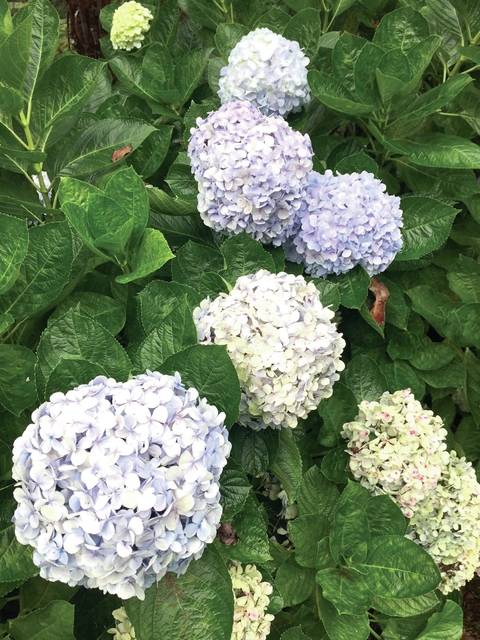As days get longer, we are seeing many seeds, bulbs and plants from temperate mainland nurseries shipped to Hawaii. We might even see tulip, hyacinth and daffodil bulbs. These are usually grown as potted plants and treated as annuals in the tropics.
Low chill fruit trees such as apple and peach also are for sale. When it comes to woody shrubs, hydrangea, camellia and roses are the most readily available.
Roses are popular throughout the mainland and normally planted in spring after the weather warms. In Hawaii, spring is anytime after January. Growing roses is always a rewarding challenge to the gardener. Roses are cool climate plants that do best at elevations of 1,000 feet or above. At lower elevations, insects and disease problems need to be seriously addressed. At best, roses require specific care or they will not do well.
Roses come in two main classes: dormant and container-grown.
The dormant rose plants usually are shipped in from the mainland in the early part of the new year. Container-grown plants are available after nurseries have given them a good start. Rootstocks vary, but research in Hawaii suggests roses grown on Rosa fortuniana rootstock are best for low elevations. Other rootstocks used are Dr. Huey, manetti and multiflora.
Plant roses for cut flowers in a separate bed because they must be pruned properly, covered most of the time with protective fungicides, and denuded of old flowers.
Select a site in a sunny location. In the event the bed is located near large plants, protect the rose bushes from marauding roots.
Prepare the planting site prior to securing the rose bushes. If the soil is rocky, remove rocks to a depth of 15 inches and replace with a compost of well-rotted leaves, aged manure, peat moss and cinder soil. For best growth, be sure the replaced material is on the acidic side. Roses do better in soils that have a generous amount of organic matter.
Be sure the planting holes are large enough to accommodate the roots without crowding. In the bottom of each hole, drop a handful of slow release garden fertilizer. Dip the roots of each plant in a bucket of water just before planting. Install the new bush so the root system will stand at the same level it stood in the nursery container.
Keep an eye out for diseases such as black spot, brown canker and powdery mildew. Insect pests that can harm the bushes include aphids, thrips, cottony-cushion scale, red spider mites and assorted night-feeding rose beetles.
Your garden supply store has specific insecticides and fungicides available. These will need to be applied with a regular program. Garden shops also have fertilizers labeled as “Rose Food.” These should be applied as directed on the container. If you want to avoid chemical sprays, consider such natural pest materials such as neem, pyrethins and tobacco.
Since roses require continuous feeding and pest control, they are placed in the high maintenance category when compared to the care required by the average flowering shrubs. The requirements also include regular “grooming,” or removing unwanted or unsightly parts from rose plants, to improve their growth and appearance.
Roses bloom throughout the year in Hawaii. Of course, this does not mean they are constantly covered with flowers, but there are five to seven periods during the year when many flowers open on a plant at one time. These peaks of flower production, or “flushes” of bloom, are separated by periods of four to eight weeks when flowers are opening. It is after each flush of bloom we find they are in need of grooming.
Approach the grooming job armed with a pair of sharp pruning shears and a portable basket or container to carry away unwanted parts trimmed from the bushes. Spent flowers should be removed by cutting just above a well-formed leaf. Just as in harvesting flowers for indoor use, trimming to remove spent flowers must include a clean, sloping cut. Long or ragged stubs should be avoided.
Preventing fruit development is one of the reasons for grooming the rose plant after each flowering period. If left on the plant, the base to which the petals are attached usually will enlarge, forming a small apple-like fruit called a rose hip. By removing the faded flowers, energy needed to form the fruit can be diverted to production of additional flowering.
At the same time spent flowers are being removed, the bush should be inspected for the presence of any dead wood that can serve as a reservoir for parasitic organisms that cause dieback of rose canes. Dead wood should be cut from the plant whenever it is found. Also, any shoots developing from the rootstock below the graft union should be removed.
Picking off yellow or brown leaves is the final step in the practice of grooming. Since these spent leaves will soon fall off naturally, their removal is of less importance than removing dead wood, spent flowers and root suckers. However, picking leaves that completed their life span and are ready to drop will improve the appearance of the plant.
Grooming, pest control and fertilization are time consuming practices, but your plants will respond by giving you loads of flowers in return.



